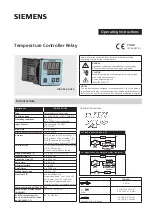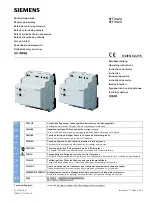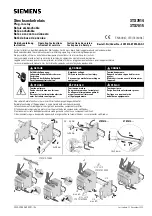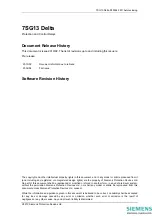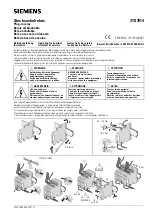
9
Connections
Terminal
Function
1-2
Phase current I
L1
, 5 A
1-3
Phase current I
L1
, 1 A
4-5
Phase current I
L2
, 5 A
4-6
Phase current I
L2
, 1 A
7-8
Phase current I
L3
, 5 A
7-9
Phase current I
L3
, 1 A
25-26
Phase unbalance current 5 A
25-27
Phase unbalance current 1 A
61-62
Auxiliary supply voltage. At d.c. auxiliary supply voltage the positive lead is con-
nected to terminal 61.
63
Protective earth
10-11
Blocking- and control input. Can be used as an external blocking input inhibiting
overload, phase unbalance or undercurrent protection. As an control input it can
be used for an external trip signal, for unlatching the trip relay and for the recon-
nection inhibit relay.
The function is selected with SGB-switches in the protection relay module.
65-66
Output relay A is a heavy duty relay which provides CB tripping commands.
A latching function of the output relay A can be selected by means of switches
SGB1/6 and SGB1/7. Switch SGB1/6 gives a latching function after an overload
tripping. Switch SGB1/7 provides a latching function after a phase unbalance trip.
The latched output relay can be reset locally or by remote control.
The undercurrent unit can be made tripping with switch SGF/2. Also the overload
stage I
a
> can be made tripping with switch SGF/1.
68-69
The signals to be routed to output relays B and C are selected with switches 5...8 of
80-81 switchgroup. The signals to be routed to output relays B and C are selected
with switches 5...8 of switchgroup SGR1 and switches 1...8 of switchgroup SGR2
of the measuring module. Normally overload stage I
b
> start signal is linked to
relay C and the overload stage I
a
> alarm signal is linked to output relay B.
77-78
The signals to be routed to the output relay D are selected by means of switches
1...4 of switchgroup SGR1. Switch SGR1/1 links the overload I
a
> alarm, switch
SGR2/2 links the oveload I
b
> start, switch SGR2/3 links the phase unbalance
alarm of stage
∆
I
1
> and switch SGR2/4 links the phase unbalance start signal of
stage
∆
I
2
> to output relay D.
74-75
Output relay E is a heavy duty output relay capable of controlling a circuit breaker.
Relay E is normally used for controlling the reconnection of the capacitor bank. If
the reconnection inhibit signal is active the output relay E prevents a reconnection
attempt of the capacitor bank. This also applies to a condition where the protec-
tive relay is out of auxiliary voltage or the relay is faulty.
70-71-72 Output relay F operates as an self-supervision output relay. Under normal condi-
tions the relay is operated and the contact gap 70-72 is closed. If a fault is de-
tected by the self-supervision system, or if the auxiliary supply fails, the output
relay drops off, providing an alarm signal by closing the NO contact 71-72.
The relay is interfaced with the SPA serial com-
munication bus through a 9-pole, D-type
subminiature connector located at the rear panel
of the relay. By means of the bus connection
modules SPA-ZC21 or SPA-ZC17 the relay can
be linked to the serial bus and further to a con-
trol data communicator, e.g. SACO 148D4 or
SRIO 500/1000M.


































